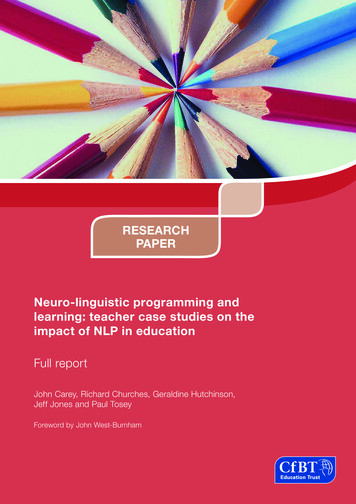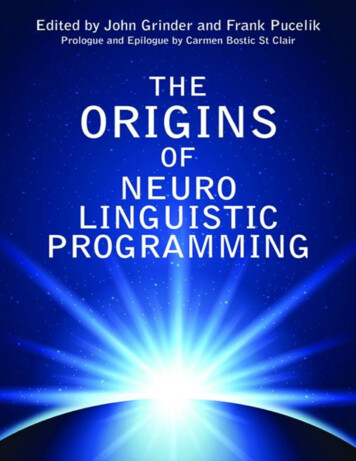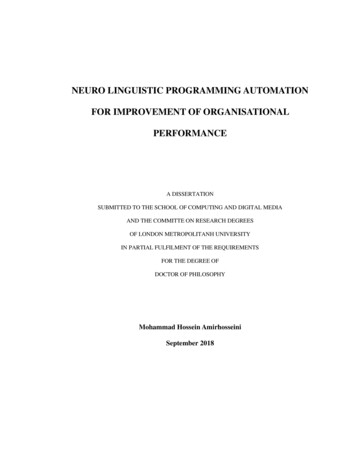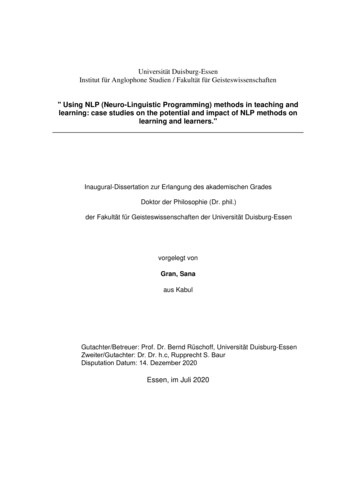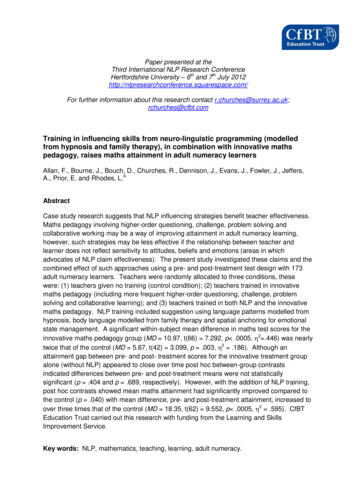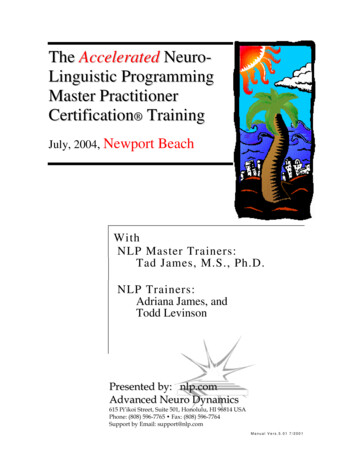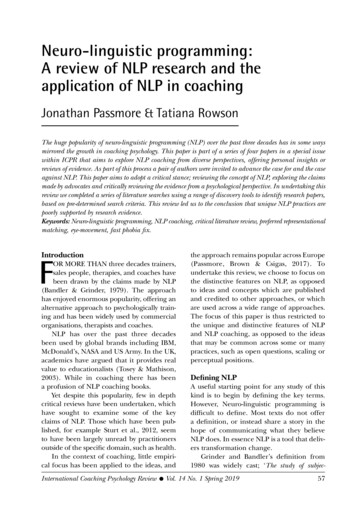
Transcription
Neuro-linguistic programming:A review of NLP research and theapplication of NLP in coachingJonathan Passmore & Tatiana RowsonThe huge popularity of neuro-linguistic programming (NLP) over the past three decades has in some waysmirrored the growth in coaching psychology. This paper is part of a series of four papers in a special issuewithin ICPR that aims to explore NLP coaching from diverse perspectives, offering personal insights orreviews of evidence. As part of this process a pair of authors were invited to advance the case for and the caseagainst NLP. This paper aims to adopt a critical stance; reviewing the concept of NLP, exploring the claimsmade by advocates and critically reviewing the evidence from a psychological perspective. In undertaking thisreview we completed a series of literature searches using a range of discovery tools to identify research papers,based on pre-determined search criteria. This review led us to the conclusion that unique NLP practices arepoorly supported by research evidence.Keywords: Neuro-linguistic programming, NLP coaching, critical literature review, preferred representationalmatching, eye-movement, fast phobia fix.IntroductionFOR MORE THAN three decades trainers,sales people, therapies, and coaches havebeen drawn by the claims made by NLP(Bandler & Grinder, 1979). The approachhas enjoyed enormous popularity, offering analternative approach to psychologically training and has been widely used by commercialorganisations, therapists and coaches.NLP has over the past three decadesbeen used by global brands including IBM,McDonald’s, NASA and US Army. In the UK,academics have argued that it provides realvalue to educationalists (Tosey & Mathison,2003). While in coaching there has beena profusion of NLP coaching books.Yet despite this popularity, few in depthcritical reviews have been undertaken, whichhave sought to examine some of the keyclaims of NLP. Those which have been published, for example Sturt et al., 2012, seemto have been largely unread by practitionersoutside of the specific domain, such as health.In the context of coaching, little empirical focus has been applied to the ideas, andInternational Coaching Psychology Reviewlthe approach remains popular across Europe(Passmore, Brown & Csigas, 2017). Toundertake this review, we choose to focus onthe distinctive features on NLP, as opposedto ideas and concepts which are publishedand credited to other approaches, or whichare used across a wide range of approaches.The focus of this paper is thus restricted tothe unique and distinctive features of NLPand NLP coaching, as opposed to the ideasthat may be common across some or manypractices, such as open questions, scaling orperceptual positions.Defining NLPA useful starting point for any study of thiskind is to begin by defining the key terms.However, Neuro-linguistic programming isdifficult to define. Most texts do not offera definition, or instead share a story in thehope of communicating what they believeNLP does. In essence NLP is a tool that delivers transformation change.Grinder and Bandler’s definition from1980 was widely cast; ‘The study of subjec-Vol. 14 No. 1 Spring 201957
Jonathan Passmore & Tatiana Rowsontive experience’ (Dilts, Grinder, Bandler &DeLozier, 1980). The definition couldinclude almost anything and fails to move uscloser a clarifying what can be included inNLP, and what should be excluded.A second example is the definitionoffered by Ready and Burton (2015, p.11)‘the study of the structure of your subjective experience.the art and science of communication .themanual for your brain.’.A third example shifts the focus towardsa focus on excellence: ‘NLP is the art and science of personal excellence. Art because everyonebrings their unique personality and style to whatthey do and this can never be captured in wordsor techniques. Science because there is a methodand process for discovering the patterns used byoutstanding individuals in any field to achieve outstanding results’ (O’Conner & Seymour, 1990,p.1). In this sense, position NLP as being theoutcome of a rigorous review process to identify evidenced-based practice across multiplefields, has echoes of the aims of psychology.However, in some ways all of these definitions are unsatisfactory and fail to adequatelydelineate NLP from other approaches.The very nature of NLP, has seen itadopt ideas and techniques from other disciplines to create a commercial model, suggesting that NLP is in some way unique,with claims of magical powers. In itself, theidea of an eclectic model, which is based onevidenced-based practice that acknowledgesthe origin or source of the idea is a noblecause. For the purpose of this paper, thefocus will thus be to separate out commonmethods from unique NLP methods.The foundations of NLPIn the 1979, Richard Bandler and JohnGrinder published Frogs into Princes (Bandler & Grindler, 1979). They argued thatoutstanding psychotherapists acted on thebasis of theory, which contributed to theireffectiveness and enabled rapport with clients. Furthermore, they concluded thatobservation of the most skillful therapistswould result in the discovery of commonor core principles, which could be gener58alised, verified on an empirical basis andput into therapeutic practice. This soundsa noble cause and one which reflects current research trends towards establishingcommon principles in coaching, and adesire to move away from multiple models,(cognitive behavioural coaching, solutionfocused coaching, psychodynamic coaching,gestalt coaching, MI, mindful coaching, etc)towards a unified approach; ‘coaching’. Sucha pathway of development has occurred inother domains, for example medicine, whichhas a single approach, as opposed to multiple ‘schools’ of training and practice withinmedicine.For several years Bandler and Grinderobserved the leading therapists of the timewho including Fritz Perls, Milton H. Erickson and Virginia Satir. They gathered material, formulateNLP tenets and hypotheses, which theybelieve were the common factors in therapy,and which had wide applicability to all communication.A number of differentiating conceptsarise within the literature. One is the ideathat ‘the Map is not the territory’. The term wasborrowed from Korzybski (1950), a linguist.This concept summarises the idea that eachindividual holds a unique internal representation of the world (the ‘map’) and not theworld itself (the ‘territory’). The maps thateach person creates is limited and distortedthrough their past experiences and culturalcontext. Applied to behavioural change, thetherapist’s task is to understand and thenwork using the client’s map to help themnavigate a passage, both expanding theirawareness and journeying from their condition to a more productive space.The maps that people make of their worldare represented by five senses: visual; kinesthetic, referring to tactical and visceral sensations; auditory, including noises and sounds;olfactory, including smell; and gustatory,including taste. Each experience in the worldinforms the continual development of themap. Bandler and Grinder suggested that eachof us processes the majority of informationInternational Coaching Psychology ReviewlVol. 14 No. 1 Spring 2019
A review of NLP research and the application of NLP in coachingusing one primary representational system.Further, they claimed that the most effectivetherapists matched the patient’s primary representational system. These ideas, developedinto primary representational system (PRS),are discussed below.A second central concept is the ideaof accessing cues, these are gathered fromobserving eye-movements. Bandler andGrinder suggested that careful observationof these movements would enable the NLPpractitioner to unequivocally identify the primary representational system of the clientand enable matching.Having identified these hypotheses, mostscientific researchers would move to thestage of formulating a hypothesis and seekingto test that hypothesis through a series ofempirical studies. For a reason that is unclear,Bandler and Grinder, missed this step of thescientific process and moved forward to publish their ideas, as if they were scientific fact.One explanation that has been proposed isthat Bandler was contemptuous of traditionalscientific methods. This led him to rejectthe tradition methods of hypothesis and testing (Witkowski, 2010). As a result the claimsmade sound scientific in nature, but lackedthe underpinning scientific testing.Synthesis of previous reviews of NLPOver the past decade a number of otherreviews have been conducted. These providea useful insight into NLP and the sciencewhich underpins the work.Early reviews of NLPOne of the first reviews of NLP researchwas conducted in response to the growing claims from NLP practitioners of theeffectiveness of NLP therapy. Einspruchand Forman (1985) in response called fora systematic review of the evidence. Onlythrough this process could a clear andevidenced-based undertaking of the effec tiveness of NLP could be established. (Heap,1998) responded with a systematic reviewedthe limited data available at the time. Henoted the mismatch between the claims ofInternational Coaching Psychology Reviewlpractitioners, which suggested miracle curesand the preliminary studies, which wereyielding less promising results. The chapterconcluded ‘If it turns out to be the case that thesetherapeutic procedures are indeed as rapid andpowerful as is claimed, no one will rejoice morethan the present author. If however these claimsare no better than the ones already investigated,then the final verdict on NLP will be a harshone indeed’ (p.276). Subsequent studies haveanswered this question.Health focused NLPIn a health study, Sturt and his colleaguesundertook a systematic review of NLP inhealth, prompted what clinicians saw as NLPpractitioners targeting the sector offeringservices, from training for health professionals to therapies available for GP referral(Sturt et al., 2012). A UK Freedom of Information (FOI) request to NHS organisationsto identify spending on NLP training orservices over a three-year period leading upto 2009. The research targeted all 143 primary care trusts, 73 mental health trusts, 166hospital trusts, 12 ambulance trusts, 10 caretrusts, and 10 strategic health authorities. Atotal of 326 (79 per cent) NHS organisationsresponded to the request and the unpublished data revealed an NHS monetaryspend of 802,468 on NLP-related activity.Over 700 NHS staff undertook NLP trainingduring the time period with the majority (75per cent) being in administrative/managerial roles. Clinical staff included counsellorsand clinical psychologists also attended. Fivetrusts had developed NLP based services,with weight loss being the most popular.The research team noted ‘no systematicreview of the NLP literature has been undertakenapplying Cochrane methods. 17 The aim of thisstudy was to conduct a systematic literature reviewand appraise the available evidence’ (Sturt et al.,2012, e758). The team gathered data from1459 studies, and excluded 1345 as not relevant, reviewing 114 abstracts, reducing thelist to 93 before a final set of 41 papers thatwere reviewed in their analysis. A further31 of these papers were excluded as theyVol. 14 No. 1 Spring 201959
Jonathan Passmore & Tatiana Rowsonwere descriptive in nature. This left a smallsample but the researchers concluded basedon their detailed review, in typical scientificlanguage ‘there is currently insufficient evidenceto recommend use of NLP for any individualhealth outcome’ (Sturt et al., 2012, e763). Fora clinical study this is damaging evidence,that form a comprehensive review of thehealth literature no robust evidence exists tosupport its use within health settings.Psychological studyIn a comprehensive psychological study theresearchers identified 315 articles of which 63studies were published in peer-reviewed journals(Witkowski, 2010). Once the descriptive studieswere excluded, the statistical data revealed thatonly 18.2 per cent showed results supportingNLP, 54.5 per cent revealed results non-supportive of NLP and 27.3 per cent offered resultswhich could be described as ‘uncertain’. In considering these results, and taking account of thebottom-draw effect, where unsupported data ismore often not published, the evidence offeredin support of NLP appears weak, with the positive results akin to what could be expected fromthe placebo effect.Witkowski (2010) noted that the numberof scientific studies had peaked during the1980s and 1990s but had declining, as if ‘theworld of science was apparently losing its interestin the concept of Bandler and Grinder’ (p.64).The author was significantly more damningin his language in concluding his analysis:‘My analysis leads undeniably to the statementthat NLP represents pseudoscientific rubbish,which should be mothballed forever’ (p.64).In wide ranging Delphi study Norcrossand Koocher (2006) surveyed a panel of 101leading psychologists to identify the most discredited theories within mental health practice. Their list include NLP as a treatment formental health conditions. NLP came 18th onthe list of most discredited, but was beatenby interventions including ‘Angel Treatment’,‘Chrystal healing’ and ‘Dolphin mental healththerapy’. Overall the researchers concludedexperts had selected these interventions dueto the lack of evidence to support their claims.60Educational studiesAn education review on the impact of NLPapproaches in education the researchersfound more positive results (Carey et al.,2011). In this first systematic literaturereview of research evidence the researchersdrew on data form both peer review and selfpublished sources from the NLP Researchand Recognition Project.The research team identified a total of111 studies. These included both quantitative and qualitative studies, includingindividual case studies and self-report data.While this offered a more comprehensivecoverage of the available evidence, it lackedthe robustness of more traditionally structured reviews which would exclude singlesample studies and experiential data. Whenreviewing the final set of papers. very few ofthe final papers were from peer reviewedjournals.Carey et al. (2011) concluded, the majority of published work was supportive of theuse of NLP in schools and education. Theauthors went on to note that given the scaleof the research, diverse methods and variation in the quality of the research theyreviewed, their results should only be considered as ‘an interim finding’ and that moreresearch was needed.Counselling reviewSharpley in a pair of studies (1984, 1987)reviewed the application of NLP in therapeutic relationships. His work included a reviewof 44 papers. His results revealed a total of sixof these papers contained positive evidencein support of NLP. His conclusion questionedthe value of NLP as a discreet method. Withrespect to individual tools, he suggested anPRS could not be reliably assessed by therapists and must be serious questioned.OverviewIn summary, a review of these sector specificstudies, suggest there is little evidence to support the claims in health, psychology andcounsellling. In education the picture is lessclear, but when considering the methodol-International Coaching Psychology ReviewlVol. 14 No. 1 Spring 2019
A review of NLP research and the application of NLP in coachingogy used, which included multiple non-peerreview sources and single case studies, a question may also be raised over these findings.Specific studiesIn addition to the large-scale reviews acrosshealth, education and therapy, we decidedto also review a number of specific studiesthat have look at individual interventionswithin NLP. We selected eye movement andPRM as two interventions to review as theyare considered essential ingredients of NLP(see de Rijk, 2019).Eye movementProponents of NLP claim that certaineye-movements are reliable indicators ofthinking patterns, including truth-telling orlying. According to this notion, a person looking up to their right suggests a lie whereaslooking up to their left is indicative of truthtelling. This is further explained by diagramX, based on the original claims made by Bandler and Grinder (1979, p.25; 1975).Diagram 1: Eye movement.Despite widespread belief in this claim,no research was undertaken to test its validity. A recent series of studies by Wisemanet al. (2012) examined this claim. In the firststudy the eye movements of participants whowere lying or telling the truth were coded,but did not match the NLP patterning. Inthe second study one group of participantswere told about the NLP eye-movementhypothesis whilst a second, control, groupwere not. Both groups then undertook a liedetection test. No significant differencesemerged between the two groups. In a thirdstudy involving coding the eye movementsof both liars and truth tellers taking part inhigh profile press conferences. Once again,no significant d ifferences were discovered.In reviewing the results from the three studies the researchers claim the results of thethree studies fail to support the claims ofNLP, and this ‘pseudo-scientific claim of eyemovement can be reliably dismissed’ (Wisemanet al., 2012).A more recent study (Ahmed, 2013)reexamined the claims regarding eye movement. Ahmed noted the criticism of Einspruch and Forman (1985), who arguedthat all 39 of the previously published studies (for example, Appel, 1983; Brockman,1981; Cody, 1983; Ellickson, 1983; Dorn,1983; Dowd & Pety, 1982; Ehrmantraut,1983; Falzett, 1981; Green, 1981; Hammer,1983 and Paxton, 1981) which had sought totest NLP claims were all false due to methodological concerns. These concerns includedthe researchers were not trained NLP specialists, or that the statements or inventionsused were not consistent, in some way, withNLP methods. Ahmed used a student sam-Table 1: Eye movement cue codes.VcVisual constructed imagesVrVisual remembered imagesAcAuditory constructed sounds or wordsArAuditory remembered sounds or wordsKKinesthetic feelings (also smell and tasteAAuditory sounds of words(Bandler & Grinder, 1979).International Coaching Psychology ReviewlVol. 14 No. 1 Spring 201961
Jonathan Passmore & Tatiana Rowsonple of 33 postgraduate MBA students, whowere invited to answer a number of questions while their eye-movement was measured. The results show that, except forvisual recall, less than half of the respondents exhibited the eye patterns (i.e. visualconstruct, verbal recall, verbal construct,kinaesthetic and auditory digital), positedby the founders of NLP. Ahmed concluded‘NLP eye patterns as claimed by the founders,do not apply to this sample of students in AbuDhabi’ (Ahmed, 2013).Research questions to measure eye movement responses (Ahmed, 2013)1 ‘Do you remember clearly the house you grew up in?’(This question involves visual recall and the eye pattern should be towards the top right.)2 ‘Can you imagine what the house would look like if it was bright pink (or had more levels)?’(This question involves visual construct and the eye pattern should be towards the top left.)3 ‘Do you have a favourite song/music? Can you play that in your head?’(This question involves verbal recall and the eye pattern should be towards the lateral right.)4 ‘Can you imagine what the song would sound like if it was played at twice the speed (or ifthe singer had a voice like Donald Duck?(This question involves verbal construct and the eye pattern should be towards the lateral left.)5 ‘Can you remember how it feels like to walk on soft sand/carpet?’(This question involves kinaesthetic and the eye pattern should be bottom left.)6 ‘Can you say the times table?’(This question involves auditory digital and the eye pattern should be bottom right.)Preferred representational matchingA second commonly used model is PreferredRepresentation Matching [PRM]. Accordingto Bandler and Grinder (1975) words, phrasesand sentences are indicative of an individual’sreferencing of each of the representationalsystems. So for example the words ‘green’,‘see-through’, ‘spiral’ and ‘image’ referencethe visual representation system, while thewords ‘silent’, ‘ringing’, ‘moo’ and ‘blast’reference the auditory representation system.These two are part of the three systems; visual,auditory, and kinesthetic that humans use,and are sometimes known as VAK.In his studies, Shapely (1984; 1987)reviewed the use of PRM in counsellingdomains. In a set of 15 studies using PRSShapely concluded there was little supportive evidence for the use of the PRS.Since these studies little further work hasbeen done to review the application of PRSthrough a scientific lens. Further work withina coaching context may help further provide62evidence on our understanding about theclaims for PRM.In summary, in reviewing generic studiesof NLP the evidence suggest that there isnot enough evidence to support NLP claimsfor specific interventions such as eye movement and PRM. In light of the lack of robustevidence validating unique NLP models,we set to explore NLP with a specific focuson coaching research. Our aim was to drawtogether published studies and examine theempirical research within NLP Coaching.MethodThe method for this review was to undertake a series of searches using commonlyused databases, through the Henley Business School One Source search tool. Thetool combines data from multiple search toolsincluding EBSCO, Science Direct, BusinessSource, Emerald, Text-direct and others.A search of peer review papers publishedbetween 1980 and 2018 produced 19,154International Coaching Psychology ReviewlVol. 14 No. 1 Spring 2019
A review of NLP research and the application of NLP in coachingitems, using the initial search term ‘NLP’.However in reviewing papers from this listit was clear that the term NLP has multiplemeanings, being used as an abbreviation fora variety of terms. The search was narrowedto ‘NLP and Neuro-linguistic Programming’.This reduced the number of items found to224 peer reviewed papers in the period 1980–2018. This was further refined in a searchto ‘NLP- Neuro- linguistic Programming –Coaching’. A total of 40 peer review paperswere identified. A detailed review of these 40papers was undertaken. This process is summarised through the PRME diagram (Figure1) showing the source and process. The fulllist of papers is detailed in Table 2.AnalysisIn reviewing these papers a number ofstriking observations appear. Firstly, giventhe period of nearly 40-year period thenumber of papers is relatively small. Thismay in part reflect the wider issue of a lackof research within coaching, although theappearance of a number of meta-studiesand systematic reviews of coaching research(Theeboom et al. 2014; Athanasopoulou& Dopson, 2018), suggests the size of theliterature pool has grown significantly inthe past decade.Secondly, the list is dominated by conceptual papers, with a lack of robust scientificdesign or traditional research methods beingused to empirically test the ideas offered byNLP within the coaching domain. In considering the 40 papers included in Table2, more than half were either conceptualpapers, literature reviews or book reviews.Only two quantitative studies were foundthrough this search, with a further sevenqualitative studies. Not a single randomisedcontrol trial was identified. This compareswith more than 40 RCT’s in coaching in thepast twenty years, which is itself consideredan under-researched area.Thirdly, several of the papers only makepassing reference to NLP, for example Reece(1999).Figure 1: PRME diagramInternational Coaching Psychology ReviewlVol. 14 No. 1 Spring 201963
Jonathan Passmore & Tatiana RowsonTable 2: Summary of NLP Coaching Peer review papers.Research studyBrief summaryGrosu, E.F., Grosu, V.T., Preja,C.A. Iuliana, B. B. (2014)Study of Romanian Judo team members using Grindler and Banderquestionnaire.Cassidy-Rice, J. (2014)Case study of a business manager suffering with phobias.Peng, T. Yun, L., Weiquan, W.,Jincong, Y. Dong, W. Yang, X,Jinzhi, X., Zengzhen, W. (2015)180 patient RCT, measuring depression and anxiety, and theawareness of stroke knowledge.Kudliskis, V. & Burden, R. (2009)Case study reviewing application of NLP in sixth form (Year 13)students in one secondary school in the South West of England.Blaskova, M., Blasko, R.,Matuska, E. & Rosak-Szyrocka.(2015)Questionnaire survey of Universities in Slovak Republic and Poland,with suggestions for how teaching quality could be improved.Boughattas, W., MIssoum, G. &Moella, N. (2017)French language journal paper using experimental design with asample of 20 junior judo competitors, with control group.Grosu, E.F., Grosu, V.T., Popovici,S. Dumitrescu, M. (2015 )Experimental design, 11 to 15 years, from Romania ski competitors. Aplanned study to explore attention and anxiety comparing NLP and acontrol group, and exploring gender differences. No results reported.Linder-Pelz, S. & Hall, M. (2008)A conceptual and case study paper with a life coaching client.Moliušytė, S & Kvedaravičius,J. (2013)A conceptual paper in Lithuanian exploring the potential of coachingand NLP to improve management performance.Knight, J. (2012)A conceptual paper review the application of NLP to qualitativeresearch.Moliušytė, S & Kvedaravičius,J. (2012)A survey of business managers and their assumptions about learningstyles of employees. The results revealed manages assume employeeshave same learning styles as they do.Laposi, E. & Dan, I. S. (2014)A review of NLP concepts in Romanian.Joey, L. & Yazdanifard, R. (2015)A conceptual paper arguing the case for NLP.Stockdale, S. (2013)A qualitative study using NLP modeling techniques as a guide to theinterview process with driving instructors exploring their teachingmethods.Tosey, P. & Mathison, J. (2010)Conceptual paper exploring links between psychophenomenologyand NLP.Bimba, A., Idris, N., AlHunaiyyan, A. Mahmud, R. B.,Abdelaziz, A., Khan, S. & Chang,V. (2016)A literature review of modeling relevant to knowledge-basedbusiness management.Continued64International Coaching Psychology ReviewlVol. 14 No. 1 Spring 2019
A review of NLP research and the application of NLP in coachingTable 2: Summary of NLP Coaching Peer review papers continuedResearch studyBrief summaryTee, S., Jowett, R. M. &Bechelet-Carter, C. (2009)A mixed methods study, using survey and interview with 10 nursingstudents on the value of coaching as a learning approach.Chuecos J. R. (2015)A conceptual paper on NLP.Alexanders, J., Anderson, A. &Henderson, S. (2015)A literature review study that reported physiotherapists appreciatethe importance of using psychological interventions within theirpractice.Hodgson, D. (2014)A qualitative study exploring cancer patient and carer’s attitudes.Concluded that training curriculum enhancements must focus ondeveloping care and compassionate behaviours.Vlok, A. (2012)A conceptual paper proposes a competency profile for innovationleaders derived from research in a South African, with reference toNLP among a wide range of other models.Gray,. E., Ekinci, Y. &Goregaokar, H. (2011)A mixed methods study examining the impact of a leadershipdevelopment programme. Coaches with therapy or NLP backgroundsperformed better than those with no therapy background. However,managers on the programme did not perceive the coaching to havehad a significant impact on their development.Anderson, J. (2007)A practitioner paper examining the role of imagination, calling andemotions in leadership, and the role intuition can play in helpingleaders, with reference to an NLP exercise for leaders to help themstay intuitive.Boussebaa, M. & Morgan, G.(2008)Case study focusing on management development, passing referenceto NLP.Reece, R. (1999)Interview with a medical doctor about his practice, with passingreference to use of NLP as a communications tool.Linder-Pelz, S. (2014)A qualitative study based on a sample of nine exploring the value ofmeta-modeling. The study concluded the approach was a valuabletool in coach competency development.Segers, J., Vloeberghs, D.,Henderickx, E., and Inceoglu, I.(2011)Survey of Belgium coaches, sample of 83 exploring coachingpractice. Noted the popularity of NLP coaching in Belgium, and thefact this was due to one of the first training schools in the countryusing this approach.Kay, D. (2013)Conceptual paper about a splinter method from NLP.Jinks, D. & Dexter, G. (2012)Conceptual paper about the limitations of coaching setting incoaching, with a passing reference to NLP.Bailey, L. F. (2014)Conceptual paper review qualitative research methods, with apassing reference to NLP as a possible research tool in qualitativeresearch interviews.ContinuedInternational Coaching Psychology ReviewlVol. 14 No. 1 Spring 201965
Jonathan Passmore & Tatiana RowsonTable 2: Summary of NLP Coaching Peer review papers continuedResearch studyBrief summaryTuraga, R. (2016)Conceptual paper offering a range of communications skills fromopen questions, non-verbal communications etc, with a passingreference to NLP.Losada, S. J. V. (2009)A Spanish paper in a practitioner journal advancing the case for roleof NLP as a useful tool in coaching and consulting.Titkos, C. (2012)A conceptual paper exploring the role of personality development.The paper argues that NLP is a specialist tool for enabling thischange along with psychodrama.Tosey, P. Lawley, J. & Meese, R.(2014)Conceptual paper making the case for ‘clean language’ as interviewtool in qualitative research.Shyamsunder, A., Anand, S.;Punj, A.; Shatdal, A. et al. (2011)Series of case study about leadership development and the role ofNLP as a communication skill forming part of a programme.Fontannaz, S ( 2017)Book Review.Woodall, J. & Douglas, D (1999)This wide-ranging paper examined ethical practice across leadershiptraining. It noted the development of NLP, questioned its lack ofethical practice and also noted that few NLP practitioners werewilling to engage in their resea
Defining NLP A useful starting point for any study of this kind is to begin by defining the key terms. However, Neuro-linguistic programming is difficult to define. Most texts do not offer a definition, or instead share a story in the hope of communicating what they believe NLP does. In essence NLP

